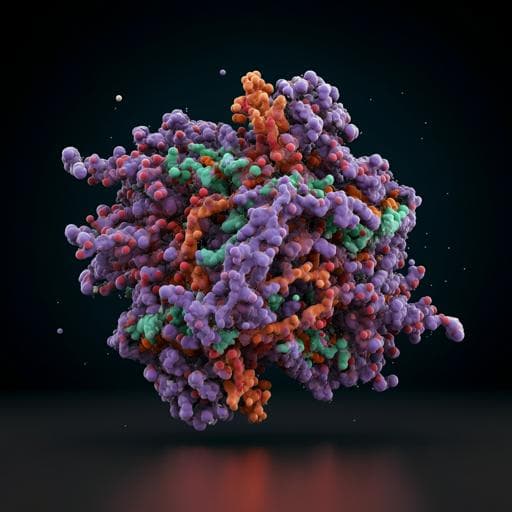
Medicine and Health
Structural and biochemical mechanism for increased infectivity and immune evasion of Omicron BA.2 variant compared to BA.1 and their possible mouse origins
Y. Xu, C. Wu, et al.
Discover how the Omicron BA.2 variant outshines BA.1 in infectivity and immune evasion in groundbreaking research conducted by Youwei Xu, Canrong Wu, Xiaodan Cao, and their colleagues. This study uncovers the structural nuances of the spike trimer that enhance ACE2 binding, revealing potential evolutionary paths in coronavirus transmission among species.
~3 min • Beginner • English
Introduction
The Omicron BA.1 and BA.2 variants of SARS-CoV-2 are highly transmissible sister variants of concern, with BA.2 overtaking BA.1 globally. Both appear to have evolved independently from prior VOCs (Alpha, Beta, Gamma, Delta), and mutation profiling suggests potential evolution involving a mouse host, though the biochemical and structural basis for mouse infection has been unclear. The trimeric spike protein mediates receptor (ACE2) binding and membrane fusion; open RBD (“up”) conformations are prerequisite for ACE2 engagement and subsequent fusion via exposure of the S2 fusion peptide. Omicron BA.1 has 37 spike mutations and BA.2 has 31, many mapping to antibody epitopes and the RBD, contributing to immune evasion. Prior studies showed BA.1 spike binds human ACE2 6–7-fold stronger than WT and is more prone to the open state. BA.2 is even more contagious, with 22 spike amino-acid differences vs BA.1. Despite generally milder disease with Omicron, antibody therapies remain important for high-risk patients. JMB2002 previously neutralized WT and BA.1 effectively; efficacy against BA.2 was unknown. This study reports cryo-EM structures of BA.2 spike with human ACE2 and with the therapeutic antibody JMB2002, and structures of BA.1 and BA.2 spikes with mouse ACE2, combined with biochemical assays, to elucidate mechanisms of increased infectivity, immune evasion, and potential mouse origins.
Literature Review
The study builds on extensive structural and functional analyses of SARS-CoV-2 spike–ACE2 interactions and conformational dynamics that established the necessity of RBD “up” states for ACE2 binding and the role of S2 fusion peptide exposure in membrane fusion. Prior Omicron BA.1 structural studies mapped mutations largely to spike surface and neutralizing antibody epitopes, and documented increased ACE2 affinity and open-state propensity for BA.1 spike. Reports indicate Omicron exhibits substantial escape from many monoclonal antibodies and reduced sensitivity to vaccine-elicited neutralization, though T-cell responses remain cross-reactive. Mouse-adapted SARS-CoV-2 lineages have acquired mutations at positions Q493, Q498, and N501 in spike RBD, implicating these residues in murine adaptation. The current work extends these insights to BA.2, detailing specific interaction changes relative to WT and BA.1 and evaluating cross-species ACE2 binding.
Methodology
- Protein expression and purification: The peptidase domain (aa 19–615) of ACE2 from human, mouse, cat, rat, dog, horse, sheep, and pig was produced using a baculovirus-insect cell system (Hi5 cells), purified by Ni-NTA and gel filtration in HEPES-buffered saline. SARS-CoV-2 spike ectodomain (ECD) trimers and RBDs for WT (D614G, furin site mutations, and 6P stabilization), Omicron BA.1 (furin site mutations, 2P), and Omicron BA.2 (furin site mutations, 6P) were obtained commercially (Sino Biological) with a T4 foldon trimerization motif and His-tag. JMB2002 IgG1 (with N297A) was expressed in CHO-K1; Fab fragments were prepared and purified via His-tag. An anti-Fab nanobody was expressed in E. coli and purified by Ni-affinity and size exclusion.
- Complex formation: For ACE2–spike complexes, spike ECD trimers were incubated with excess human or mouse ACE2 (molar ratio 1:5) on ice and purified by size exclusion chromatography (Superose 6 Increase) in TBS. For Fab–spike complexes, spike was mixed with JMB2002 Fab and anti-Fab nanobody (1:5:6), incubated on ice, and purified by SEC in HBS.
- Cryo-EM sample prep and data collection: Samples were vitrified on glow-discharged gold R1.2/1.3 grids using a Vitrobot at 4 °C/100% humidity. Data were collected on a Titan Krios with Gatan K3 detector at 300 kV, nominal magnification 105,000x (pixel size 0.824 Å), dose ~50 e−/Ų over 36 frames/2.5 s. Datasets included BA.2 spike–hACE2, BA.2 spike–JMB2002 Fab, BA.2 spike–mACE2, and BA.1 spike–mACE2.
- Image processing and model building: Motion correction (MotionCor2) and CTF estimation (CTFFIND4). Particle picking, 2D/3D classification, refinements, and local refinements were performed in cryoSPARC. Local refinements focused on RBD–ACE2 interfaces. Initial models from PDB (e.g., BA.1 spike–hACE2) and SWISS-MODEL (mACE2) were fit in UCSF Chimera; manual rebuilding in COOT; refinements in PHENIX with torsion restraints; validation via PHENIX cryo-EM tools; figures prepared in Chimera/ChimeraX/PyMOL.
- Biolayer interferometry (BLI): Dimeric human ACE2 immobilized on Protein A biosensors to quantify binding of WT, BA.1, and BA.2 spike ECD trimers (Octet Red96e, 1:1 global fit). Monomeric ACE2 from multiple species was biotinylated and immobilized on SA biosensors to measure spike ECD binding. JMB2002 binding to biotinylated BA.2 spike was measured similarly. Apparent KD values computed using Octet Data Analysis HT 12.0.
- Thermal shift assays (TSA): Spike ECDs (0.5 mg/mL) were mixed with SYPRO Orange and heated from 25–80 °C on a LightCycler 480 II; Tm values derived from melting curves.
- Pseudovirus neutralization: BA.2 pseudovirus was incubated with serial dilutions of JMB2002 IgG, then applied to HEK293-hACE2 cells; luciferase readout after 48 h; IC50 derived by four-parameter logistic fit.
- Data deposition: EM density maps and coordinates deposited to EMDB/PDB with accession codes EMD-33336 to EMD-33345 and PDB IDs 7XO4–7XOD.
Key Findings
- Enhanced ACE2 binding: Dimeric hACE2 bound BA.2 spike trimer with KD = 0.4 ± 0.1 nM, ~11-fold higher affinity than WT (4.7 ± 0.6 nM) and ~2-fold higher than BA.1 (0.75 ± 0.1 nM). Monomeric hACE2 bound BA.2 with KD = 3.2 ± 0.7 nM vs WT 15.0 ± 0.6 nM and BA.1 6.4 ± 1.0 nM.
- Cryo-EM stoichiometries and conformations: BA.2 spike–hACE2 complexes exhibited two states: 3:3 and 3:2 hACE2:spike binding, with ~42% and ~58% particle proportions, respectively. All three RBDs were in the open “up” conformation in the 3:3 state, explaining strong ACE2 binding propensity (vs BA.1 previously showing only 1 hACE2 per trimer).
- Structural basis of increased hACE2 affinity: BA.2 RBD mutations Q493R (salt bridge with hACE2 E35) and Q498R (salt bridge with hACE2 D38) enhance binding; K417N loses a WT salt bridge. BA.2 RBD exhibits increased stability relative to BA.1 (Tms: BA.2 RBD 47.4 ± 0.2 °C; BA.1 44.5 ± 0.1 °C; WT 52.5 ± 0.1 °C). BA.2 spike trimer shows lower Tm2 than BA.1, indicating a more dynamic trimer.
- JMB2002 antibody potency against BA.2: JMB2002 Fab bound BA.2 spike with KD ≈ 2.6 ± 0.1 nM; JMB2002 IgG bound with KD ≈ 0.3 ± 0.1 nM. JMB2002 neutralized BA.2 pseudovirus with IC50 = 0.2 ± 0.1 µg/mL (similar to BA.1). Cryo-EM showed three Fabs bound per spike (to two up and one down RBD), whose binding sterically clashes with hACE2 binding sites, fully blocking ACE2 engagement.
- Cross-species ACE2 binding: Mouse ACE2 (mACE2) bound BA.2 and BA.1 spike trimers with high affinity (BA.2 KD = 2.9 ± 0.2 nM; BA.1 KD = 9.1 ± 7.1 nM), but showed no binding to WT spike. Cat ACE2 bound WT and Omicron variants comparably; rat and dog ACE2 did not bind WT or Omicron spikes. Horse, pig, sheep ACE2s showed decreased binding relative to human ACE2.
- Structural basis for mACE2 binding: High-resolution structures of BA.2/BA.1 spike trimers with mACE2 revealed extensive interactions. BA.2 RBD–mACE2 interactions include Y449–(D38/Q42), N487–N24, T500–(Y41/D355), Q493R–(N31/Q34/E35), Q498R–(D38/Q42), and N501Y–H353 (π-π stacking). The combination of Q493R, Q498R, and N501Y is essential for mACE2 binding; analogous interactions are not satisfied by WT RBD.
- Comparative ACE2 binding networks: Superposition of BA.2 RBD bound to hACE2 vs mACE2 showed highly similar interaction networks and overall alignment (RMSD ~0.48 Å over 670 Cα atoms), consistent with high affinity to both receptors.
- Mutation mapping: BA.2 spike harbors 31 mutations (23 surface, 3 interior), with 22 differing from BA.1; 16 reside in RBD (including BA.2-unique S375F, T376A, D405N, R408S, N440K), potentially contributing to immune evasion.
Discussion
The markedly increased affinity of BA.2 spike for hACE2 (~2-fold vs BA.1 and ~11-fold vs WT) likely contributes to BA.2’s enhanced transmissibility, as spike–ACE2 engagement is the first step in viral entry. Cryo-EM demonstrated that BA.2 spike samples states with two or three RBDs in the “up” conformation simultaneously, favoring multivalent ACE2 binding and potentially facilitating entry. Specific RBD mutations (Q493R, Q498R) strengthen electrostatic interactions with hACE2, while BA.2 RBD exhibits higher stability than BA.1 (via D405N-mediated interactions), which may further enhance binding by reducing entropic penalties. Despite extensive immune escape mutations, the overall spike architecture remains largely conserved outside key epitope clusters. The therapeutic antibody JMB2002 retains high-affinity binding and potent neutralization against BA.2; structural analysis shows that its epitope engagement on both up and down RBDs sterically blocks ACE2 binding, providing a mechanistic basis for its broad efficacy across Omicron sublineages. Cross-species analyses revealed strong binding of BA.1/BA.2 spikes to mouse ACE2 but not of WT spike, with structural data identifying Q493R, Q498R, and N501Y as critical to mACE2 binding. Together with prior observations of analogous mutations in mouse-adapted SARS-CoV-2, these findings support the plausibility of a mouse-involved evolutionary route for Omicron, with implications for surveillance and control strategies across animal reservoirs.
Conclusion
This work elucidates structural and biochemical determinants underlying BA.2’s increased infectivity and immune evasion relative to BA.1 and WT. BA.2 spike shows higher affinity for hACE2, a propensity for multiple RBDs in the up conformation, and an RBD stabilized relative to BA.1, collectively supporting enhanced transmissibility. The therapeutic antibody JMB2002 maintains potent binding and neutralization against BA.2 by sterically occluding ACE2 binding across RBD conformations. Cross-species binding and structures indicate that Q493R, Q498R, and N501Y enable high-affinity mACE2 engagement, suggesting a potential human–cat–mouse–human evolutionary pathway for Omicron variants. Future research should include in vivo validation of cross-species infectivity and transmission, continued development of broad-spectrum antibodies resilient to RBD mutations, and enhanced surveillance of potential animal reservoirs to inform public health strategies.
Limitations
- The proposed human–cat–mouse–human evolutionary pathway is speculative and not directly demonstrated; cross-species binding data and structural insights do not establish transmission chains in vivo.
- Neutralization was assessed using pseudovirus systems rather than live BA.2 virus, which may not fully capture all aspects of viral entry and antibody efficacy.
- Binding measurements utilized stabilized spike ectodomains (with furin site and proline mutations), which could influence conformational equilibria and absolute affinities compared with native viral spikes.
- Other determinants of infectivity and pathogenicity (e.g., protease usage, fusion kinetics, replication dynamics, and host factors) were not evaluated here.
- Cross-species ACE2 analyses for some species were limited to binding assays and homology models without corroborating infection studies.
Related Publications
Explore these studies to deepen your understanding of the subject.







